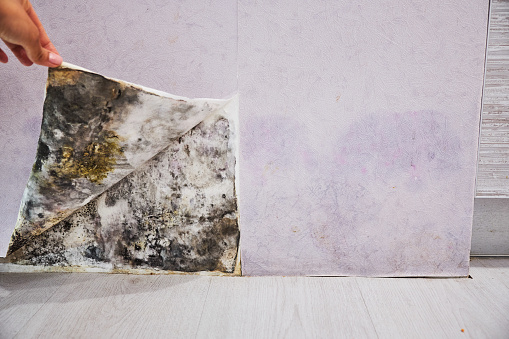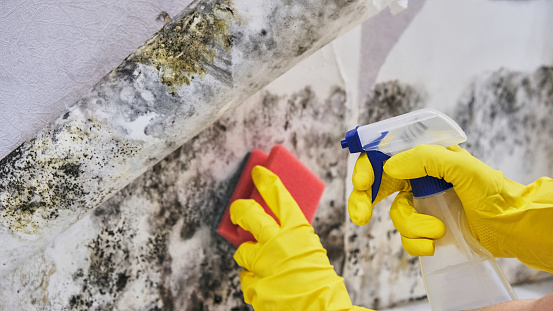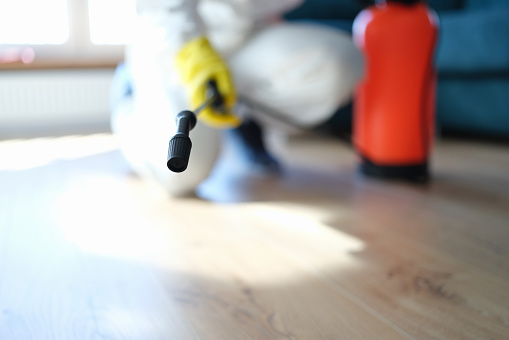Have you noticed a musty smell in your home? Have you seen mold or mildew growth in your crawl space? Is your family suffering from allergy-like symptoms? If you answered yes to any of these questions, you might have a mold problem in your crawl space.
Mold is a type of fungus that thrives in damp, humid environments. It can cause structural damage to your home and serious health problems for your family. Mold remediation is the process of removing mold from your home.
This guide will show you 8 easy steps for mold remediation in crawl space. From identifying the source of the problem to preventing future growth, we’ll cover everything you need to know to get rid of mold for good.
What Causes Mold Growth in Crawl Spaces?
Several factors can contribute to mold growth in crawl spaces. Some of the most common include:
- Poor Ventilation: Crawl spaces are often poorly ventilated, creating humid conditions ideal for mold growth.
- Leaky Pipes: A leaky pipe can cause water damage and create the perfect environment for mold to grow.
- Flooding: If your crawl space has been flooded, it’s important to dry it out completely to prevent mold from growing.
- High Humidity: Humid conditions can promote mold growth, so it’s important to keep the humidity level in your crawl space low.
Crawl Space Mold Varieties
Several types of mold can grow in crawl spaces. The kind of mold present affects how you get rid of it and repair any damage. You may find clusters, patches of white powder, or dirt on girders, posts, or floor joists. These fuzzy-looking species are more common in spring, summer, or fall. Also, black mold varieties appear as flat, greenish-gray, or dark-gray patches. They don’t look fuzzy or powdery. Additionally, yellow mold can consume wooden structures in your home and cause significant decay. The four most common types of crawl space mold are:
1. Stachybotrys
Known as black mold, Stachybotrys is one of the most toxic mold species. It commonly grows in insulation or sub-flooring that has gotten wet or been exposed to moisture, as well as on the carpet, drywall, or beams. It can be distinguished by its distinctive black color and musty odor. If you suspect black mold, it is always advised to let a professional mold remediation crew handle the issue.
2. Penicillium
It might sound like the name of an antibiotic, but penicillium is a type of harmful mold that often grows in crawl spaces with dirt floors and decaying vegetation. This mold can release toxins into the air, causing breathing problems for people allergic to them. Also, because this mold is often difficult to spot, it can quickly spread and cause extensive damage to your home.
3. Cladosporium
With the ability to cause devastating health consequences, Cladosporium is a potent species of mold. It typically feeds and grows on soil, painted wood, woody plants, clothing, paper, HVAC systems, painted walls, and mattress dust. A few mold spores can quickly multiply and spread to other areas of the house, posing a serious contamination risk. If you have any of these items in your crawl space, it’s important to take immediate action to remediate the situation.
4. Aspergillus
The most common mold found in homes and crawl spaces is Aspergillus. These spores aren’t considered as dangerous as some of the others. However, there is still concern that long-term exposure can create sinus irritation, acute or chronic lung infections, and allergic reactions. With the ability to grow indoors, Aspergillus thrives in HVAC ductwork and damp crawl spaces, as well as outdoor spaces.

8 DIY Mold Removal Steps To Follow
Before starting your mold removal, you should understand that certain risks are involved. You need to protect yourself from exposure to mold spores. They can cause serious respiratory problems, skin irritation, and other health issues.
Also, consulting with a professional is always recommended to get the job done safely.
But, if you’re set on removing mold, here are eight easy steps for mold remediation in crawl space.
1. Find The Source Of Moisture
Mold can’t grow without moisture. So, the first step in mold removal is finding and eliminating the source of moisture. This could be a leaky pipe, condensation, or flooding. Once you’ve found the source of moisture, you can fix the problem and dry out the area to prevent mold from growing back. Also, make sure to ventilate the area to prevent condensation from occurring.
2. Inspect The Area
The next step is to inspect the area for mold. Look for black, green, or white patches of mold. Mold can also appear as discoloration on walls or ceilings. It’s important to note that mold can be hidden behind wallpaper or carpets. Use a flashlight to inspect dark areas.

3. Remove Moldy Materials
Once you’ve found mold, you’ll need to remove any moldy materials. This includes drywall, insulation, carpeting, and anything else contaminated by mold. These materials should be disposed of immediately. It’s also important to wear protective gear, such as a respirator, gloves, and goggles when handling moldy materials.
4. Use Foaming Spray And Mold Cleaner
For hard-to-reach areas, you can use a foaming mold removal spray. This type of spray will reach into small crevices and remove mold. Also, it’s important to follow the directions on the label.
Then, soak the area with bleach or another EPA-registered mold cleaner. Commercial products are usually more effective compared to bleach.
5. Scrub-Off Residue
Once you’ve sprayed the area with bleach or another mold cleaner, you’ll need to scrub off the residue. Use a stiff brush and scrub vigorously. Be sure to rinse the area well after scrubbing. Also, don’t forget to wear protective gear while scrubbing.

6. Dry The Area Thoroughly
After scrubbing the area, it’s important to dry it thoroughly. This will help prevent mold from growing back. Use fans or a dehumidifier to dry the area completely. Also, dispose of any rags or sponges used to scrub the moldy area.
7. Repair The Source Of Moisture
Once the area is dry, you’ll need to repair the source of moisture. This could be a leaky pipe or condensation problem. Fixing the problem will help prevent mold from growing back in the future.
8. Don’t Risk Your Health
DIY mold remediation is possible, but it’s not worth risking your health. If you have any allergies or respiratory problems, it’s best to call in a professional. Additionally, if the mold covers multiple areas larger than 3 square feet or the affected areas include damaged or rotted wood, calling in a professional is your safest option. You want the job done right, and a professional has the experience and expertise to get it done quickly and effectively.
Also, using the proper safety gear is essential when dealing with mold. A professional will have the right gear, including an airtight suit, gloves, and a respirator.

Assessing Damage From the Mold Growth
After you’ve removed the mold and taken the necessary precautions to prevent its growth, you should assess the damage. Open all windows and doors to allow fresh air to circulate. This will help to get rid of any lingering musty odors.
Next, you’ll need to identify areas where the mold has caused damage. This can be anything from water damage to structural damage. If you find any damaged areas, it’s important to have them repaired as soon as possible to prevent further mold growth.
In some cases, the mold growth may have caused the insulation to become wet. If this is the case, you’ll need to remove the affected insulation and replace it with new material.
Once you’ve assessed the damage, you’ll need to decide whether or not you need to call in a professional to help with the remediation process. If the mold growth is extensive, it’s best to hire a professional with experience dealing with this type of problem.
How To Prevent Mold In The Future?
Once you’ve assessed the damage and taken the proper remediation steps, you’ll want to focus on preventing mold in your crawl space in the future. While keeping your crawl space free of moisture can be tricky, it’s not impossible. Here are a few tips:
1. Install A Vapor Barrier
One of the best ways to prevent mold growth in your crawl space is to install a vapor barrier. A vapor barrier is a thick, heavy plastic sheeting placed on the ground and walls of your crawl space. It acts as a barrier to moisture, preventing it from seeping into your crawl space and causing mold to grow.
2. Seal Any Gaps or Cracks
Ensure no gaps or cracks in the foundation walls. These cracks can allow moisture to seep into your crawl space and cause mold outbreak. To prevent this, you’ll need to seal any cracks or gaps with a waterproof sealant.
3. Use A Dehumidifier
Using a dehumidifier in your crawl space will help to remove any excess moisture from the air. This will prevent mold spores from being able to grow and thrive. Also, be sure to empty the dehumidifier regularly so that it can continue to work effectively. A humid crawl space creates several other issues as well.
4. Keep The Crawl Space Ventilated
Proper ventilation is key to preventing mold growth in your crawl space. You can help keep the space dry and free of moisture by ensuring good airflow. This can be achieved by installing vents in the crawl space or using a fan to circulate the air.
5. Keep The Area Clean
Keeping your crawl space clean is important for preventing mold growth. Be sure to sweep and vacuum regularly to remove any dirt, dust, or debris that could lead to mold growth.
Inspecting your crawl space regularly for any signs of mold growth is important. If you do see mold, be sure to take action immediately to remediate the problem.
FAQs
1. What Are The Signs Of The Presence Of Crawl Space Mold?
The most common sign of mold is the presence of musty odors. Other signs include visible mold growth, water staining, and damage to building materials. Also, people sensitive to mold may experience respiratory problems, such as coughing and wheezing. The discolored crawl space components are another sign of serious mold growth.
2. How Does Mold Grow In Crawl Spaces?
Mold usually grows in crawl spaces due to high humidity levels and moisture. The most common source of moisture is water leaks, such as from a broken pipe or plumbing leak. Condensation can also contribute to mold growth.
3. Is Health Risk Associated With Mold In Crawl Spaces?
Mold can cause several health problems, such as respiratory problems, allergies, and asthma. People with weakened immune systems are at a higher risk for more serious health problems. Also, some types of mold can produce toxins that can harm people.
4. What Are The Best Methods For Mold Removal?
There are several mold removal products available, but the best method depends on the size and severity of the mold problem. For small areas of mold growth, bleach and other disinfectants can be effective. For larger areas of mold growth, it is best to hire a mold remediation specialist.
5. What’s The Cost Of Mold Removal?
The mold removal cost depends on the mold problem’s size and severity. For small areas of mold growth, the cost of a mold remediation company is typically between $100 and $500. The cost can be several thousand dollars for larger areas of mold growth. But, the cost of not to kill mold can be much higher.
6. What Are The Risks Of Do-It-Yourself Mold Removal?
There are several risks associated with do-it-yourself mold removals, such as exposure to mold spores and toxins, improper cleanup, and damage to building materials. It is important to follow the instructions carefully and to use the proper safety gear when removing mold.


